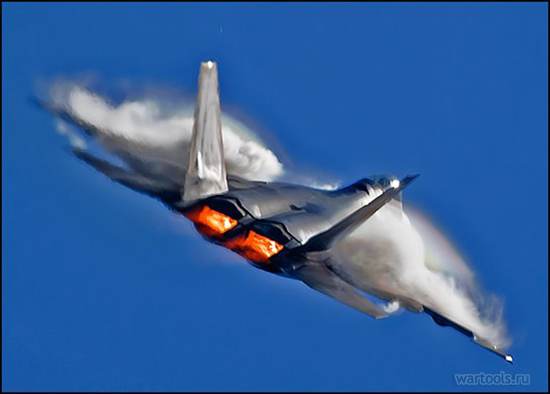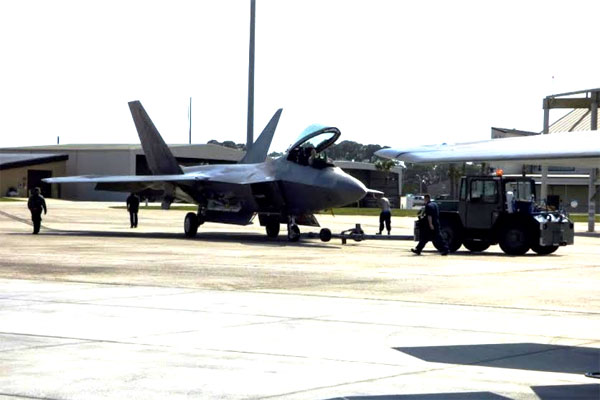An F-22 Raptor is towed to its hangar on Feb. 27 at Tyndall Air Force Base, Fla. (Military.com photo/Oriana Pawlyk)
Military.com | 26 Mar 2017 | by Oriana Pawlyk
When the
F-22 Raptor production line ceased in 2011,
Air Force Lt. Col. Daniel thought the Pentagon had made a huge mistake.
He was driving in his car in 2009 when he found out "the Raptor fleet is done at 187, and I remember thinking, 'This is not great.' I thought it was an error."
Because, "more is better than less, right?" said the F-22 pilot of the 95th Fighter Squadron. He spoke to Military.com on the condition that his last name not be used, due to safety concerns amid ongoing air operations against the
Islamic State.
Military.com recently sat down with a few pilots and a maintainer at
Tyndall Air Force Base in Florida, as part of a trip to observe fifth-generation F-22s flying with fourth-generation F/A-18 Hornets for training.
The Air Force originally wanted at least 381 Raptors. Had the service acquired that many of the stealthy twin-engine fighters from Lockheed Martin Corp., life nowadays might be somewhat less hectic for the service members who fly and maintain them.
More of the F-22 fleet could "mitigate [operations] tempo, and we're always on the road so if we had more Raptors, there'd be more Raptor squadrons, more Raptor maintainers that would mitigate some training and operational demands," Daniel said.
Lt. Col. Ben of the 325th Operations Group agreed.
"That's exactly right," he said. "But these decisions are above my pay grade."
Daniel added, "Of course, there's a huge cost with that."
He's right. Indeed, cost was the driving factor behind then-Defense Secretary Bob Gates' decision to push for the Pentagon to prematurely stop buying the aircraft.
$20 Billion Restart
According to
a 2010 RAND study, to restart the F-22 production line to build 75 more of the jets would cost about $20 billion in inflation-adjusted dollars.
To build a new Raptor -- not a 1990s version -- "you're not building the same airplane you were building before, and it becomes a much more expensive proposition," a defense analyst in Washington, D.C. told Military.com on background on Thursday.
"So do you build a new ‘old’ F-22, or do you build an improved one?" the analyst said.
And that figure is a rough estimate to restart a marginal lot of planes. It doesn't take into account the cost of hiring workers, integrating newer stealth technologies, or training and equipping additional pilots.
Preparing Raptor pilots to fly from the nest takes time, too.
"To make a really good F-22 pilot, I need about seven to eight years to get him to where he is fully employing a jet and can actually quarterback the whole fight," Daniel said.
But as the Air Force weighs retiring
its F-15C/D fleet sometime in the mid-2020s (though lawmakers in Congress will have a say in the matter), many defense experts question how the service plans to maintain its air superiority. For example, will the F-22 eventually take over the role of the
F-15 Eagle? If so, will Raptor pilots be more in demand than ever?
F-16s Instead of F-22s?
The questions aren't abstract. Both the active-duty component and
Air National Guard are considering retiring the Boeing-made Eagle, service officials told the House Armed Services Subcommittee during
a hearing on Wednesday. The
F-16 Fighting Falcon could take over missions from the F-15, they said.
Rep. Martha McSally, an Arizona Republican and former Air Force officer who flew the
A-10 Thunderbolt II ground-attack aircraft, said "prior to the F-22, [the F-15] was the best at air-to-air." The F-16, a fixed-wing, single-engine, fourth-generation platform, "doesn't bring the same capability," she said.
The reference by Air Force officials to F-16 rather than F-22 during the hearing also caught the analyst by surprise.
"Why didn't the Air Force say F-22 restart?" he said during a telephone interview. "Why did they leak that they're looking to replace it with F-16s instead of using it as a case to examine F-22 restart?"
One reason might be because the Senate hasn't yet confirmed Heather Wilson,
a former Congresswoman nominated by President Donald Trump, to become the next Air Force Secretary, the analyst said. Until she's confirmed, "the Air Force is worried about making any major decisions," he said.
Another reason might be because Air Force leaders have zero interest in restarting the F-22 production line. The reference to F-16 may suggest "this is the end for F-22 restart story -- not the beginning of it," he said.
Upgrades Coming
Earlier this week, officials at Lockheed -- which produces the F-16 and F-22 --
told DefenseOne it plans to move the F-16 production line to South Carolina from Fort Worth, Texas, where it built the single-engine fighters for more than 40 years.
As of Sept. 30, the Air Force had 949 Fighting Falcons, according to Air Force inventory figures obtained by Military.com.
By comparison, the service has less than half as many Eagles and F-15E Strike Eagles. The F-15 inventory totals 456 aircraft and is split almost evenly between the two variants, with 236 of the older Eagles, including 212 one-seat F-15C models and 24 two-seat F-16D models, according to the service data.
"F-15C/D is just one job," the analyst said of the all-weather, tactical fighter. "The Air Force is going to make the
same argument it made on the A-10, which is, 'As we look around the Air Force to save money, we're going to retire things that have one job.'
"The F-16 is multi-role … and the F-16 has grown significantly since it was just a little squirt under the F-15's wing," he said.
For example, in December, Raytheon Co. was awarded a contract to upgrade the F-16 computer system as part of the Modular Mission Computer Upgrade, which features "more than two times the current processing power and 40 times the current memory, equipping USAF pilots with near-fifth-generation aircraft computing power," the company said in a release at the time.
Related Video:
F-22 Raptors at Air Combat Exercise Red Flag 17-1
Just this past week, the Air Force announced the 416th Flight Test Squadron at
Edwards Air Force Base in California has begun testing F-16s equipped with Northrop Grumman's APG-83 Scalable Agile Beam Radar, a fifth-generation Active Electronically Scanned Array fire-control radar.
"It is intended to replace currently used APG-66 and APG-68 radars and provide the F-16 with advanced capabilities similar to fifth-generation fighters like the F-22 Raptor and
F-35 Lightning II," the service
said in a release.
The Air Force claims it has the capacity in the F-16C community "to recapitalize … radar to serve the same function as the F-15 has done and thereby reduce the different systems that we have to sustain and operate, so that makes it more efficient," said Maj. Gen. Scott D. West, director of current operations and the service’s deputy chief of staff for operations at the Pentagon.
The effort will help minimize the number of systems pilots operate, West said during the hearing on Capitol Hill.
As for the Eagle, Air National Guard Director Lt. Gen. Scott Rice told Military.com that any planned upgrades will be fulfilled. However, the Air Force may want to look at the next block of upgrades to save on future sustainment and operational costs, he said.
Rice said he believes the Air Force is getting beyond comparing aircraft platforms, "especially in the digital age" when looking at the platforms as systems and "how they integrate is as important and, in the future, will be even more important than the platform itself," he said.
The F-16 is a "less capable dogfighter than the F-15," the analyst added, "but at the same time the question is, 'How realistic is it that you're going to have a single F-16 without any help'" from other fighter jets? "That's not how we plan to fly," he said.
A Magical Airframe?
Last year, the House Armed Services Air and Land Forces subcommittee
tasked the Air Force to issue a study of what it would take to get the F-22 line up and running again.
Whether the official study has been completed, "preliminary assessment showed it was cost prohibitive to reopen the F-22 line," an Air Force spokeswoman told Military.com on Thursday, in line with RAND's study.
Even so, Lockheed is offering advice on what it would take to do so, said John Cottam, F-22 program deputy for the company in Fort Worth.
"They have come to us and have asked us for inputs into that study, so we have been working very hard with them, in concert with them to provide that data," he said last month. "With this new administration, they have priorities that are putting Americans back to work and making America strong, so we believe that what the Air Force provides could very easily resonate with the administration's policies."
Cottam added, "As time goes on, if the report isn't delivered [to Congress], we can then keep delivering our responses and making it more and more refined."
Meanwhile, Raptor pilots can't help but wonder if newly minted aircraft will again come off the production line.
In any exercise, pilots show up the first couple of days, "integrate with other platforms -- everyone's trying to learn," Daniel said. "By the end of the first week, everybody realized we need about 30 more F-22s in the lane because as soon as the F-22s leave, people start to die in the air-to-air fight."
Daniel said, "It's always disappointing that we don't have more, or don't have more missiles, more gas -- it's always frustrating as an F-22 pilot when you hear, 'Bingo, bingo,' and you're out of missiles and you go home and you start hearing other planes getting shot down."
The stealth, the speed, the "unfair amount of information the jet provides to us … .it's magic," he said.
Even with oncoming upgrades to the F-16, many fighter pilots and others question whether a fourth-generation fighter will -- or could -- ever step up to such a role.












